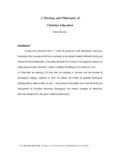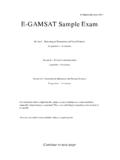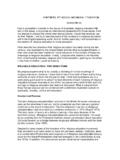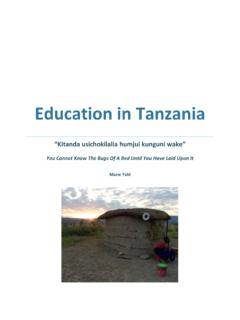Transcription of Challenges Facing Higher Education in the Twenty …
1 5. Challenges Facing Higher Education in the Twenty -First Century Ami Zusman The Twenty -first century has brought with it profound Challenges to the nature, values, and control of Higher Education in the United States. Societal expectations and public resources for Higher Education are undergoing fundamental shifts. Changes both within and outside the academy are altering its character its students, faculty, governance, curriculum, functions, and very place in society. As Clark Kerr and Marian Gade noted nearly 20 years ago, crisis and change in Higher Education have been the rule, not the exception.
2 Neverthe- less, current changes are transforming Higher Education to an extent perhaps greater than since the end of World War II. This chapter focuses on the impact of major external influences on Higher Education , particularly government and market pressures, and in turn, the impact of resulting institutional decisions in matters such as program choices, tuition charges, and the conduct of research on outcomes of Higher Education for society at large. The five issues addressed here discuss changing answers by the public, policy makers and Higher Education to central questions about the value, role and control of Higher Education : Who pays for Higher Education ?
3 Who benefits? Who decides who should benefit, what should be offered, and what the outcomes should be? By necessity, of course, other significant issues are omitted from this discussion. While each of the five issues raises all three questions, for this discussion they are organized as follows: ISSUES EXAMINED. Who Pays? Growing privatization of public colleges and universities A more commercialized and politicized research system? Who Benefits? Who will attend college? Challenges to access The changing and uncertain job market for 's Who Decides?
4 Accountability, governance, and coordination A common thread runs through these issues: Challenges to the content of colleges' and universities' social contract. These Challenges are apparent in ongoing conflicts over public and private benefits of Higher Education , equity and merit, undergraduate and graduate Education , basic and commercially oriented research, or institutional autonomy and public control. The Growing Privatization of Public Colleges and Universities States today have become minority partners in the colleges and universities that typically bear their names.
5 On average, states now supply only a little over one-third of public colleges' revenues. Yet because these funds generally pay most basic instructional costs, such as faculty and staff salaries, state support remains critical to public institutions. Over the next decade, a combination of acute state revenue constraints, compet- ing demands for state resources, and ongoing changes in public attitudes toward Higher Education will likely result in continued shrinking and unpredictable state support for Higher Education .
6 Although many private colleges are also Facing serious budget difficulties due to rising costs, market limits on tuition increases, reduced private giving, and declining endowment income, public institutions, which generally have less ability to tap private sources, will be hit harder. This section addresses the far-reaching impacts of declining state support for public institutions in the , which enroll three-quarters of all college students and two- thirds of all students in four-year colleges. Shrinking State Funding for Higher Education Because Higher Education is the largest discretionary item in states' budgets, state funding for Higher educa- tion tends to rise when the economy and resulting state revenues are good and to drop during recessions.
7 Even during boom times, funding may be less than it appears once inflation and rising enrollments are taken into account. During the economic recession of the early 1990s, states cut Higher Education appropriations by amounts unequalled in constant dollars since at least World War II, despite enrollment growth. In the late 1990s, state funding per student finally began returning to pre-1990 levels only to be cut almost immedi- ately during the recession early in the new century. As a result, state dollars per student in public institutions were 12 percent lower in fiscal year 2004 than they were 15 years earlier, as Figure shows, despite an improving revenue picture in many states.
8 Although state funding patterns varied widely, 23 states allocated less money in 2004 than in 2003, even without considering inflation or enrollment growth, with nine states reporting cuts of five percent or more. Enrollments $ per FTE. in thousands 10,000 $10,000. 9,000 $9,000. 8,000 $8,000. 7,000 $7,000. 6,000 $6,000. 5,000 $5,000. 9 0 1 2 3 4 5 6 7 8 9 00 01 02 03 4. -8 -9 -9 -9 -9 -9 -9 -9 -9 -9 -9 0- 1- 2- -0. 88 89 90 91 92 93 94 95 96 97 98 20 00 00 00 03. 19 19 19 19 19 19 19 19 19 19 19 99- 2 2 2 20.
9 19. Public FTE Enrollments (in thousands) Dollars Per Public FTE Student Figure Public Higher Education Enrollments & State Appropriations to Higher Education Per Student, 1988-89 to 2003-04 (in constant 2003 dollars). Sources: (1) Funding: Appropriations of State Tax Funds for Higher Education Operating Expenses 50 States, Grapevine (Normal: Illinois State University, Center for the Study of Education Policy, 2004), and State Higher Education Executive Officers (SHEEO), 2003: ; (2) Students: National Center for Education Statistics, Projections of Education Statistics to 2013 (Washington, : Department of Education , 2003), table 22.
10 (Enrollment data for 2001-02 to 2003-04 are projected.). Long-term prospects for state Higher Education funding are not favorable. Many experts believe that states'. revenue problems will persist even after the economy improves because state tax systems are obsolete for example, a growing percentage of economic activity is in non-taxed services and Internet sales and because voter-imposed limits have made raising revenues more difficult. At the same time, an estimated 40-50 percent of state expenditures is locked up in mandated program costs, particularly for K-12 Education and Medicaid.





